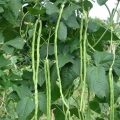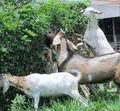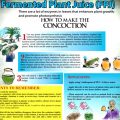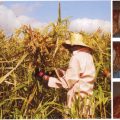Pole sitao is also known as long-podded cowpea, asparagus bean, snake bean, or Chinese long bean. In other dialects it is known as dau gokin Cantonese, thua fak yao in Thai and kacang panjang in Indonesian and Malay, sitawin Tagalog, utong in Ilokano, latoy in Ilonggo, bora in the West Indies, and vali or eeril in Goa, India. The pods of this crop are about half a yard long, despite what the name suggests; the subspecies, sesquipedalis (one-and-a-half-foot-long), is rather an exact approximation of the pods’ length.

Thinking just how famous pole sitao or simply sitao is? It is the fifth mentioned vegetable in one of the most popular children’s songs in the Philippines, the “Bahay Kubo”. This climbing herbaceous plant is also an ingredient of the original yummy Ilocano dish, pinakbet or mixed veggies with bagoong and some meat chunks and cooked to perfection.
Pole sitao is a great source of fiber and a variety of nutrients such as protein, vitamin A, thiamin, riboflavin, iron, phosphorus, and potassium, and is a very good source for vitamin C, folate, magnesium, and manganese. In a 100g serving size of pole sitao there are 47 calories, 0 grams of total fat, 0 mg cholesterol, 4 mg sodium (0 percent daily value), 8 grams of total carbohydrates (2 percent daily value), and 3 grams of protein (5 percent daily value). There is also 17 percent DV vitamin A, 2 percent DV iron, 31 percent DV vitamin C, and 5 percent DV calcium. (Percent daily values are based on a 2000 calorie diet. Individual daily values may be higher or lower depending on individual calorie needs.)
The Bureau of Agricultural Research annually conducts the National Research Symposium (NRS) to promote the best products of agriculture and fisheries R&D and to give due recognition to outstanding researchers and scientists in agriculture and fisheries through the AFMA Research Paper Award. Through the NRS, BAR aims to identify and disseminate significant information on new technological breakthroughs that would improve the agriculture and fisheries R&D sector.
In 2012, the paper titled, “Development of Organic Varieties of Pole Sitao (Vigna unguiculata (L) Walp.subsp. sesquipedalis (L.) Verdc.)”, won the silver award in the 24th NRS. The study basically employs breeding, segregation and pedigree selection of pole sitao. An added factor which makes it more unique and remarkable is that the breeding work is geared for organic agriculture.
The study is led by Rodel G. Maghirang, Gloria S. Rodulfo, Fatima Amor M. Tenorio, and Maria Emblem O. Grulla from the Institute of Plant Breeding- University of the Philippines Los Baños (IPB-UPLB), and Milagros Cacal of the Palawan Agricultural Center of the Palawan Agricultural Experiment Station (PAES). It sought to address the problems of low vigor, vulnerability to pests and diseases which all lead to yield losses. Eventually, the group succeeded in producing pole sitao cultivars that outperformed the existing varieties.
Plant breeding is basically the art and science of changing the genetics of plants in order to produce desired characteristics; it is the deliberate manipulation of plant species in order to achieve desired genotypes and phenotypes for specific purposes (Sleper, 1995).
Meanwhile, FAO/WHO Codex Alimentarius Commission defined organic agriculture as “a holistic production management system which promotes and enhances agro-ecosystem health, including biodiversity, biological cycles, and soil biological activity. It emphasizes the use of management practices in preference to the use of off-farm inputs, taking into account that regional conditions require locally adapted systems. This is accomplished by using, where possible, agronomic, biological, and mechanical methods, as opposed to using synthetic materials, to fulfill any specific function within the system.”
Those two terms guided the development of the new cultivars of pole sitao by the team of Dr. Maghirang. The main objective of the study is to select, breed and recommend pole sitao varieties that perform well under organic agriculture conditions. The specific objectives include the production of varieties that are suitable to this specific environment in comparison to the existing commercial variety and to evaluate and recommend the varieties for organic agriculture. The study was conducted in experimental stations and on-farm.
Under a DA-BAR funded project in 1999, the performance evaluation of pole sitao under organic conditions was initially done. In 2005 this was followed by hybridization and pedigree selection under organic conditions. Cultural management aspects such as minimal weeding and minimal pest control measures, and the use of composted manures and compost materials for soil health and fertilization were carried out for the organic agriculture environment. Further breeding, segregation and pedigree selection until F6 (6th filial generation) of pole sitao that will perform better under organic conditions than the recommended commercial variety were done. Ten F6 lines were assessed and compared to a commercial check variety (Sandigan) using established parameters for selection such as vigor, earliness, pod quality and acceptability, pest and disease resistance, storability, and yield under a two-season trial.
In summary, the results of the study show that breeding under organic conditions resulted to the selection of potential organic varieties of pole sitao. Among the entries, 10116-1-1-0-0, 0801-5-1-1-0, 10421-0-0 and 1096-1-1-0-0 outperformed the check variety, Sandigan, with total yields of 25.26t/ha, 25.19t/ha, 24.9t/ha, and 26.19t/ha for the first trial, respectively; and total yields of 15.31t/ha, 19.39t/ha, 17.6t/ha, and 18.07t/ha, respectively for the second trial. Additionally, these lines are moderately to highly resistant to pest and diseases, have good storability, and acceptable pod qualities. Under an initial on-farm trial in Palawan, the two preferred entries, 10421-0-0 and 1096-1-1-0-0, both had high yields and good pod qualities.
Yes, it is a malignant truth and it’s not new to our ears that some vegetable producers apply synthetic pesticides and fertilizers excessively with the worst case scenario being that the fruits and pods are dipped in a container containing a mixture of those chemicals to “improve their crops’ yield and growth performance” but sacrificing the health of unaware consumers in the process. However, with this development in organic pole sitao, we are one step closer to a healthier and safer choice. ###
———-
For more information, please contact Dr. Rodel G. Maghirang, Vegetables and Legumes Section, Institute of Plant Breeding, University of the Philippines Los Baños through telephone no. (049) 576-0089, mobile: 09157400788 or email: rgmaghr@yahoo.com
References:
1. http://www.bar.gov.ph/agfishtech-home/crops/207-vegetables/1298-polesitao
2. Sleper and Poehlman. 1995. Breeding Field Crops.
Maghirang, RG, Rodulfo GS, Tenorio FAM, Cacal M and Grulla MEO. Development of Organic Varieties of Pole Sitao (Vigna unguiculata (L) Walp.subsp. sesquipedalis (L.) Verdc.). Vegetables and Legumes Section, Institute of Plant Breeding- Crop Science Cluster, College of Agriculture, University of the Philippines Los Baños
Source: Wilson G. Viloria II, BAR Digest April-June 2013 Issue (Vol. 15 No.2)






